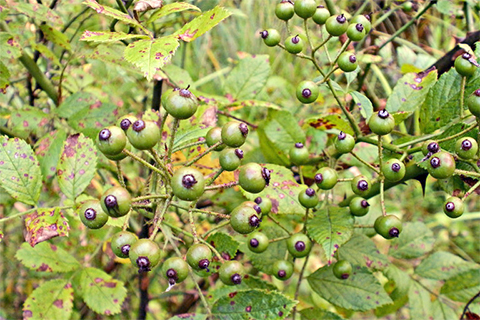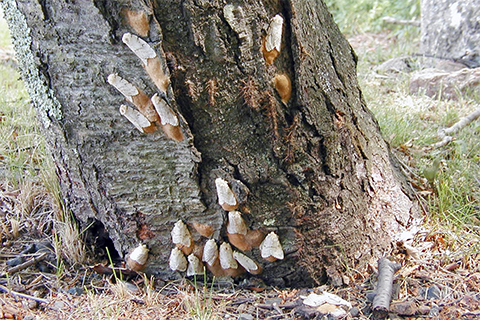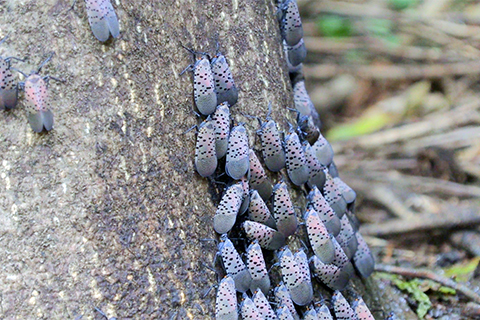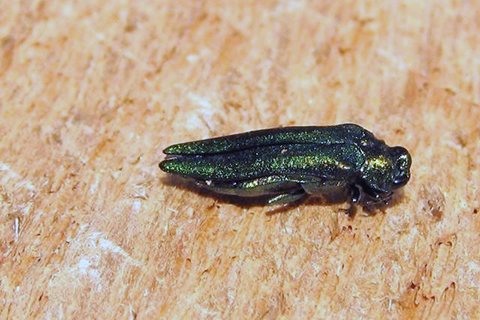All over the world, invasive species cause harm to ecosystems on a widespread scale in terms of reducing biodiversity -- the diversity of plant, wildlife, and other species within a specific area.
Biodiversity is the life support system of our planet -- we depend on it for the air we breathe, the food we eat, and the water we drink.
When invasive species enter an environment, they can take over and out-compete native plants and wildlife which impacts the diversity of species within that environment.
It’s hard to believe, but some invasive species were brought here intentionally. Long ago, natural resource managers could not anticipate the long-term damage some of these invaders would cause.
Intentional Introduction and Release

Multiflora rose, Ansel Oommen, Bugwood.org
Resource extraction, such as logging and mining, that lead to the Industrial Revolution left barren lands that were once filled with trees and grassy meadows.
This overuse of the land, along with improper farming practices, made erosion of farmable lands a top issue for conservationists.
This time period, historically known as the Dust Bowl Days, compelled the formation of the Soil Conservation Service in 1935. An idea proposed to stem the loss of soil was to grow “living fences” of vegetation that would trap and hold the soil.
One plant that was introduced from Asia to do this job was the now common multiflora rose.
This thorny shrub forms impenetrable thickets and grows very easily in riparian areas, where its inedible leaf litter can have effects on aquatic wildlife.
A productive and hardy plant, multiflora rose quickly spread throughout the U.S. and Pennsylvania, outcompeting native plants for space on the landscape and harming the ecosystem.
Intentional Introduction and Accidental Release

Gypsy moth
The invasive gypsy moth was first documented in Pennsylvania in 1932, 63 years after a researcher from Massachusetts, Etienne L. Trouvelot, imported them from Europe.
Trouvelot thought he could breed the gypsy moth with the silkworm moth to produce a superior silk-producing hybrid, but the gypsy moth caterpillars escaped -- commencing an American invasion with overwhelming consequences.
Gypsy moth larvae are very hungry feeders, and outbreaks lead to major leaf loss throughout affected forests.
Bare tree canopies, droppings from gypsy moths that sound like falling rain, and forest floors covered in snips of leaf confetti are typical and disturbing forest conditions during a gypsy moth outbreak.
A severe outbreak renders a Pennsylvania forest canopy entirely leafless; and can cause significant tree mortality -- particularly among oaks.
Accidental Introduction

Spotted lanternfly
One invasive species having widespread effects today is an example of accidental introduction -- the spotted lanternfly.
First discovered in Berks County in 2014, this invasive insect is believed to have arrived from Asia as a “hitchhiker” on imported decorative stone.
In the absence of the major predators of their homeland, spotted lanternflies multiply relentlessly, swarming trees and man-made structures.
Their preference for grapevines and many species of ornamental and forest trees poses a serious threat to forests, landscapes, and agriculture.

Emerald ash borer
Another species transported to the U.S. by “hitchhiking” is the emerald ash borer, which is believed to have arrived first in Michigan via pallet wood during the early- to mid-1990s.
Emerald ash borer was later documented in western Pennsylvania in 2007; and have since killed tens of millions of ash trees in Pennsylvania and throughout North America.
The still-standing skeletons of affected ash trees mark forests in every Pennsylvania county.
The final toll of the ash borer invasion is yet to be determined, but their destruction of ash populations statewide is a sad and undeniable reality.
Two other iconic Pennsylvania tree species have suffered a similar fate from wood “hitchhikers” -- the American chestnut and American elm.
Early in the 20th century, the pathogen that causes Dutch elm disease arrived in imported elm wood; and the chestnut blight fungus made entry to the U.S. in a shipment of Japanese chestnut trees.
Both diseases killed hundreds of millions of trees, with the American chestnut now considered functionally extinct.
Intentional Introduction and Escape from Cultivation

Golden bamboo, Chuck Bargeron, University of Georgia, Bugwood.org
Many invasive plants and trees were brought to the U.S. and Pennsylvania as ornamental landscape or garden specimens.
Dozens of invasive plants in Pennsylvania fit into this mode of invasion.
This label applies to the Japanese barberry, tree-of-heaven, bamboo, and garlic mustard.
All four species escaped the boundaries of their intended site; multiplied due to a lack of competition; and now occupy vast ranges in Pennsylvania.
Bamboo has been widely used and valued for its quick-growing nature and use as a privacy screen in residential areas.
Colonies of bamboo completely eliminate all forest floor plants that stand in its way. It leaves little appropriate habitat for wildlife, sharply decreasing biodiversity. Once established in an area, it is quite difficult to remove.
What You Can Do to Stop the Spread
- Never transport non-native biological material (such as firewood, plants, animals and insects) into Pennsylvania.
- Never release non-native (exotic) pets and plants -- like snakes, fish, insects, and bamboo -- into the environment.
- Learn to identify invasive species and attempt to remove them.
- Replant barren areas with native plants.
Learn more about invasive forest pests and diseases at the DCNR website.